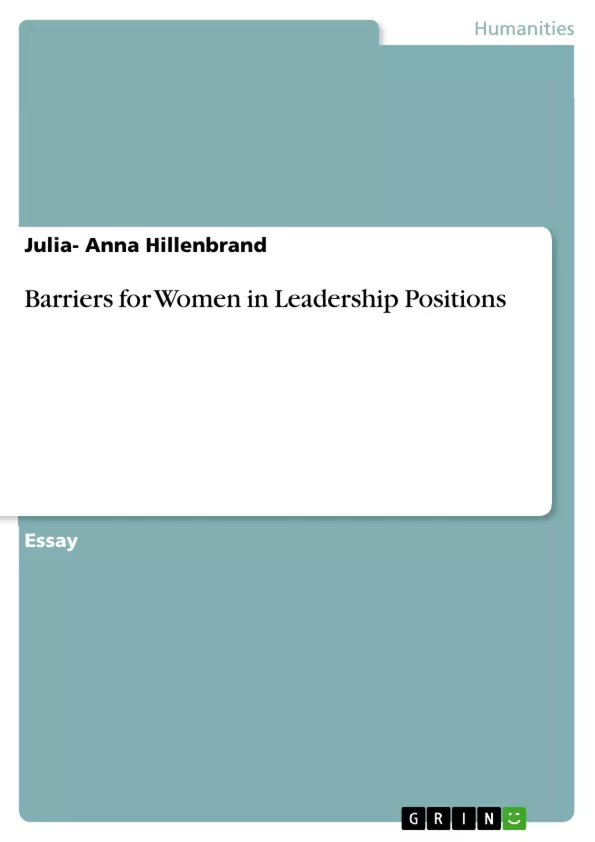Leaders are powerful, so when women are excluded from top leadership positions, they are denied power to make a difference in the world. This paper thus aims to discuss the many challenges women nowadays face in taking leadership positions, including barriers related to stereotypes, cultural expectations and the choice between work and family.
The lack of women in top management positions, which can be felt all across the world, pertains to one of the biggest economic challenges our fast growing international economy needs to face. Leadership is regarded as one of the most studied issues of our times: countless books and articles discuss theories and the nature of the problem. Even when there have been several attempts in the past trying to overcome the gender gap, and even when women have already made progress in leadership positions, the gender gap continues to be a prevalent issue.
Table of Contents
- 1. Introduction
- 2. Women in Leadership
- 2.1 Status and Development
- 2.2 Reasons behind the Leadership Gap
- 2.3 Solutions for Eliminating the Leadership Gap
Objectives and Key Themes
This paper aims to examine the challenges women face in attaining leadership positions, focusing on barriers stemming from stereotypes, cultural expectations, and work-family conflicts. It analyzes the current status of women in leadership globally and explores potential solutions to close the gender gap.
- The global status of women in leadership positions
- The impact of societal stereotypes and cultural expectations on women's leadership opportunities
- The challenges of balancing work and family responsibilities for women
- Potential solutions for increasing the representation of women in leadership roles
- The different leadership styles between men and women
Chapter Summaries
1. Introduction: This introductory chapter sets the stage by highlighting the significant global economic challenge posed by the underrepresentation of women in top management positions. It emphasizes the extensive research already conducted on leadership and the persistent gender gap despite past efforts. The paper's objective is clearly stated: to analyze the challenges women face in leadership roles, focusing on stereotypes, cultural expectations, and work-family balance, and to propose concrete solutions for addressing the issue. The chapter establishes a framework for the subsequent analysis, promising an examination of statistics, underlying reasons for the gap, and practical recommendations for its elimination.
2. Women in Leadership: This chapter provides a comprehensive overview of the representation of women in leadership, examining both the current status and historical development. It presents global statistics illustrating the slow but steady growth in the percentage of women in senior roles, using data to demonstrate the continuing disparity. Specific examples, such as the underrepresentation of women in senior positions in Japan and the European Union, are provided to illustrate the widespread nature of the problem. The chapter then transitions into a discussion of factors contributing to the gender gap, laying the groundwork for a deeper analysis in subsequent sections. The slow pace of progress highlights the ongoing challenge despite some improvement.
Keywords
Women in leadership, gender gap, leadership styles, work-family balance, stereotypes, cultural expectations, solutions, gender diversity, career paths, leadership programs, flexible working conditions.
Frequently Asked Questions: A Comprehensive Language Preview
What is the overall focus of this document?
This document provides a comprehensive preview of a paper examining the challenges women face in achieving leadership positions. It analyzes the global status of women in leadership, explores contributing factors like stereotypes, cultural expectations, and work-family conflicts, and proposes solutions to address the gender gap.
What topics are covered in the Table of Contents?
The table of contents includes an introduction and a main chapter focusing on women in leadership. The chapter on women in leadership is further divided into sections covering status and development, reasons behind the leadership gap, and solutions for eliminating the gap.
What are the key objectives and themes explored?
The paper aims to analyze the challenges women face in attaining leadership roles, focusing on barriers stemming from stereotypes, cultural expectations, and work-family conflicts. It examines the global status of women in leadership, explores the impact of societal factors, and proposes solutions to increase women's representation in leadership.
What does the chapter on "Women in Leadership" cover?
This chapter provides a comprehensive overview of women's representation in leadership, examining the current status and historical development. It presents global statistics, illustrating the slow but steady growth in the percentage of women in senior roles, while highlighting the persistent disparity. It also discusses factors contributing to the gender gap.
What are the key takeaways from the introduction?
The introduction highlights the significant economic challenge posed by the underrepresentation of women in leadership. It emphasizes the existing research on the gender gap and clearly states the paper's objective: to analyze the challenges women face and propose concrete solutions.
What solutions are suggested to address the gender gap in leadership?
While specific solutions aren't detailed in the preview, the document indicates that potential solutions for increasing the representation of women in leadership roles will be explored. The preview suggests this may involve addressing issues related to stereotypes, cultural expectations, and work-family balance.
What keywords are associated with this document?
Keywords include: Women in leadership, gender gap, leadership styles, work-family balance, stereotypes, cultural expectations, solutions, gender diversity, career paths, leadership programs, and flexible working conditions.
- Quote paper
- Julia- Anna Hillenbrand (Author), 2017, Barriers for Women in Leadership Positions, Munich, GRIN Verlag, https://www.grin.com/document/428133



